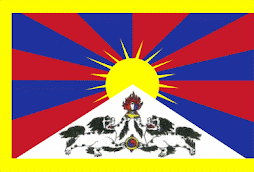
The three old mates gathered beneath a tree are sharing memories. Like any men their age, they've collected plenty. But these are stories no one wants to have to tell.
Sonam Choepel, 75, and his fellow exiles Abu Gaga, 71, and Sonam Topgyal, 67, are among the few surviving Tibetans who took part in their country's first uprising against Chinese rule which erupted in the Tibetan capital, Lhasa, 50 years ago this Tuesday. During the conflict their leader, the Dalai Lama, fled Tibet and has remained in exile in India since.
The three men served a combined total of 53 years in Chinese prisons for their role in the 1959 uprising. Now, along with Tibetans all over the world, they are preparing to commemorate the most significant and sombre anniversary in Tibet's history - March 10, 1959.
Last week they recalled images that haunt them still, even in their new home on Sydney's northern beaches.
"It began at about midnight on March 10," said Sonam Choepel. "The Chinese army let off bombs all over Lhasa. In the morning, the city was full of dead bodies. The streets were running with blood." Sonam was one of thousands of civilians who took up arms after years of escalating tensions between his people and the Chinese Communist government, which had been claiming sovereignty over Tibet since taking power in 1949.
"I remember the Chinese People's Liberation Army starting to arrive in Lhasa in the early '50s," he said. "They were helping with the farms, building roads, as if they meant well, but it was a trick. They gradually settled around Lhasa and set up army camps. More soldiers kept coming. They started to tell the Tibetan government what to do. And then the tanks came."
Sonam Topgyal knew those tanks already. He was a boy living in Kham in eastern Tibet, home to farmers and nomads, where the initial build-up of Chinese troops began.
His people, the Khampas, are renowned for their dogged resistance - often on horseback and armed only with daggers - against the vast, sophisticated Chinese army. They were the first to fight back against what Tibetans regarded as a hostile invasion. "I remember they looked so different from us . . . their faces, uniforms and language. They brought weapons we had never seen."
Sonam Choepel remembers his first encounter with tanks in Lhasa in the months before the March uprising. "When I first heard them, the ground was shaking as if the world was turning upside down. It was terrifying. But over time we grew used to the tanks and our fear changed to anger."
On March 10, 1959, it burst forth as 300,000 Lhasa citizens surrounded the Dalai Lama's summer palace, the Norbulingka. Their leader was inside and they feared for his safety. In response, the Chinese troops shelled the Norbulingka and the Dalai Lama's main residence, the Potala Palace. By March 17 the Dalai Lama had fled to the Indian border in disguise.
Sonam Choepel was arrested and spent 22 years in prison. "I tried to escape twice and I was caught and tortured a lot," he said. "They handcuffed my hands behind my back for six months. When they released the cuffs, my arms were paralysed. I could not eat or reach the front of my body."
Abu Gaga, who was still fighting in the resistance years after the 1959 uprising, was captured in 1962 and remained in prison until 1979. He was handcuffed for nine years. Sonam Topgyal has deep scars on his wrists from the manacles he wore for much of his stretch in a Chinese prison from 1968 to 1982, after he was captured fighting in the resistance. He still wears his hair long in the Khampa style. It's a gesture of defiance as well as tradition.
On Tuesday, the three friends will travel to Canberra to join Australia's Tibetan community in a peaceful protest outside Parliament House and the Chinese Embassy.
The significance of half a century of exile is overlaid with painful memories of unrest across Tibet during last year's 49th anniversary. Tibetans will hold placards representing the scores of their countrymen still unaccounted for after the subsequent Chinese crackdown.
Australian Tibetans with family or friends inside the Tibetan Autonomous Region and ethnic Tibetan areas receive snatched, often coded messages of an intensifying military presence and erosion of basic freedoms. In the past fortnight protests have flared up in the Amdo Ngaba area, a focus of the 2008 unrest. On February 27, a monk from Kirti Monastery set himself on fire in protest before being shot at and arrested by security officers.
Tibetan refugee Lobsang Lungtok Ralo, 37, of Dulwich Hill, sees ominous historical parallels. He participated in the 1987 protests, which were the fiercest in Tibet since 1959 and resulted in 13 months of martial law. "Tibet has once again become a giant prison," he said.
Sydney's three witnesses to the 1959 unrest lost more friends than most. "All these people are now appearing before my eyes, like I am watching a movie," said Sonam Choepel. "But none of us regret fighting for Tibet. I still believe all this suffering will benefit our cause and that one day Tibet will be free."
IN
http://www.smh.com.au/world/our-50-years-of-agony-20090307-8rwf.html?page=-1


















No comments:
Post a Comment